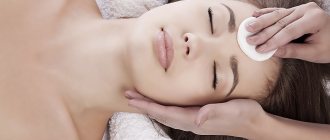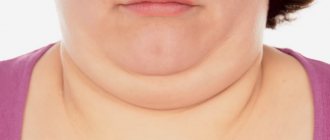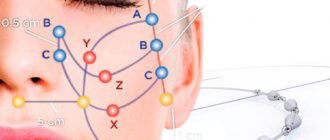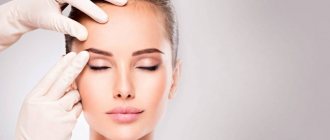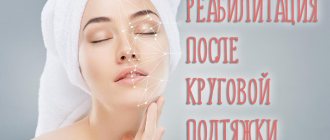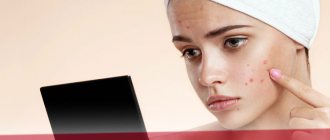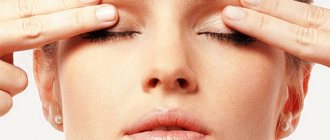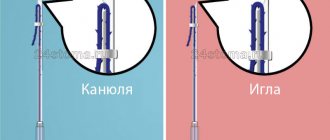Ultrasonic face lifting is a hardware method for correcting age-related changes, which consists of influencing the superficial muscular-aponeurotic layer of SMAS (Superficial Muscle-Aponeurotic System) with ultrasound.
The SMAS layer is located slightly deeper than the subcutaneous fatty tissue and serves as a supporting framework for the skin. Over time, collagen fibers stretch and the supporting capabilities of the SMAS weaken, leading to sagging skin. Ultrasonic lifting provides thermal effects at SMAS depth, causing compression of collagen fibers and tightening of all layers of soft tissues of the face.
What is ultrasonic lifting?
Ultrasonic lifting is a rejuvenation method that, at first glance, seems very simple. The specialist simply moves the sensor of a special device over the skin of the face. Deep penetration into the skin does not occur, since there is no pressure, intricate massage movements and other external manifestations of intense work. But at the same time, during the procedure, facial tissue is strongly influenced, not only on the skin, but also on the neuromuscular fibers located underneath it. It is the depth of impact that distinguishes ultrasonic lifting from other procedures included in the arsenal of hardware cosmetology.
In terms of the depth of impact on tissue, ultrasonic lifting is similar to surgical lifting, since the impulses penetrate the skin several millimeters and even reach the muscles
Ultrasonic impulses, penetrating to a considerable depth through the epidermis and dermis, reach subcutaneous fat and even muscle fibers, triggering restoration processes. Soft tissues, reacting to the action of ultrasound, shrink and muscles contract, resulting in a lifting effect. The face seems to be pulled upward. In addition, collagen and elastin begin to be intensively produced, and cell regeneration accelerates.
The procedure copes with all the main signs of aging: loss of elasticity, ptosis, wrinkles, etc. Moreover, after an ultrasonic lifting session, as after many cosmetic hardware treatments, in some cases side effects are observed (for example, the appearance of bruises), but there are no wounds, burns or scratches. For this reason, the procedure is considered absolutely safe.
Types of procedure
As a rule, clinics offer ultrasound lifting on various areas of the face and body. This allows the procedure to be carried out only in those places where it is really necessary, which is especially important when taking into account its cost.
The following types of ultrasonic lifting are distinguished:
- general (whole face), so-called circular lift - from 70 thousand;
- periorbital zone (around the eyes: it is correct to treat both the upper and lower eyelids at the same time, since this is the same circular muscle) - from 16 thousand;
- submandibular zone - from 23 thousand;
- necks - from 33 thousand;
- upper third of the face - from 20 thousand;
- middle and lower third of the face - from 60 thousand.
In addition, clinics offer lifting of the neckline, hips, abdomen, shoulders, knees and even elbows.
The operating principle of ultrasonic tightening devices is the same, so it is not customary to distinguish types of procedures depending on the device used. In any case, this will be the so-called SMAS lifting, that is, lifting the SMAS layer of skin corresponding to the muscular aponeurotic system. Therefore, when you see this unfamiliar word, you should not think that one of the devices is capable of some kind of super effect that is inaccessible to other devices.
Ultrasonic waves, entering the layers of facial tissue, expand, positively influencing not only the areas in the immediate area of influence, but also neighboring areas
The most popular devices:
- Ulthera (Altera systems) made in the USA. Perhaps the most popular today.
- Double. The device is made in Korea and is distinguished by its prevalence and quality.
- U-one. Like the previous device, from Korea. Cheaper and may cause discomfort during the session.
Advantages and disadvantages of SMAS lift
SMAS ultrasound lifting has a lot of advantages that have made this procedure popular among women and men.
These include the following:
- with ultrasound exposure, all layers of the epidermis are affected - superficial and middle, fatty layer, muscular aponeurotic, deep tissues of the dermis;
- You can lift any parts of the face and neck;
- high effectiveness of procedures;
- short rehabilitation process;
- no marks or scars remain after treatment;
- during the procedure, the supply of oxygen and nutrients to the skin cells increases due to increased blood flow;
- pores become significantly narrower and the “orange peel” disappears;
- acne is effectively treated;
- Only 1 session is performed, no need to visit a cosmetologist for a long time;
- can be carried out in any season;
- the effect lasts 1-3 years;
- safety of the method.
After ultrasound rejuvenation, all facial features are tightened, the shape of the face is restored, and the double chin disappears.
Disadvantages of ultrasound procedures:
- the presence of a large number of contraindications;
- the appearance of bruises and hematomas;
- some pain during manipulation.
This is where the disadvantages of the SMAS lift end, which makes this rejuvenation method almost indispensable in modern cosmetology.
Indications
Ultrasonic lifting copes with most problems associated with skin aging:
- loss of clarity of facial contours;
- flabbiness;
- manifestations of ptosis in any area, including in the area of the upper eyelid;
- double chin;
- expression wrinkles;
- bags under the eyes.
The procedure can also be performed as a preventive measure against aging. Perhaps the only thing that lifting cannot cope with is deep senile wrinkles. Cosmetologists and their clients draw an analogy between ultrasound exposure and surgical rejuvenation, but this comparison is very conditional. In any case, in the presence of serious age-related changes that require the elimination of part of the sagging skin, surgical methods have no analogues.
Ultrasonic facelift combats all major signs of aging
How does rejuvenation occur?
As we have already indicated above, with the help of ultrasound, tissues are heated and collagen production is stimulated. But how can this still rejuvenate our skin?
The fact is that collagen is the protein that makes our skin tight, elastic and young. Collagen levels constantly decrease, causing the skin to become more saggy. It has been proven that exposure to high-intensity ultrasound at a certain depth and in a certain dosage causes the coagulation of old and the production of new collagen to restore damaged areas.
Contraindications
The ultrasonic lifting procedure is considered absolutely safe, but still has a certain number of contraindications:
- diseases of the nervous system (epilepsy, etc.);
- During pregnancy and breastfeeding;
- inflammatory diseases in the acute stage;
- implants in the affected area (except for dental ones);
- fillers;
- cardiovascular diseases and wearing a pacemaker;
- diabetes;
- oncological diseases;
- herpes in the rash stage;
- connective tissue diseases;
- severe, especially purulent inflammation in the area of intended exposure.
How is ultrasonic lifting performed?
Ultrasonic lifting is very convenient because it does not require any preliminary preparation.
The procedure itself is carried out in the following order:
- Makeup remover
- Anesthesia. It can be produced either with special gels or through injections.
- Treating the skin with antiseptic agents.
- Skin examination and marking. The cosmetologist draws lines on the face that define the areas where various sensors will be used.
- Applying a special gel to the skin.
- Direct exposure to ultrasonic radiation. The entire process is displayed on the device’s monitor, so the cosmetologist has the opportunity to observe and adjust the depth and nature of wave penetration. As a rule, the procedure is carried out in two stages. First, a general lifting of all tissues is performed, and then a more targeted and powerful effect on problem areas.
- Cleansing the face from markings.
Before the ultrasonic lifting procedure, the cosmetologist applies special markings to the face
The duration of each procedure is about one hour. Their quantity is discussed with the cosmetologist individually. For some women, one session is enough, but many note that to obtain a lasting effect, it is necessary to complete a whole course. It all depends on the initial condition and characteristics of the skin, as well as the equipment used.
Repeated exposure is necessary every 1-2 years.
Most often, the effect of ultrasonic lifting appears after 2-3 months, so if after visiting a cosmetologist no changes are visible, then you just need to wait. Although it happens the other way around: the result is visible immediately, but disappears very quickly. However, this is a rare case.
Follow-up skin care
If everything went well, then within half an hour after exposure the skin will be the same as it was before visiting the cosmetologist. There won't even be any redness left. Therefore, it will not require any special care. However, in any case, experts recommend that clients take care of facial tissue for 3-5 days:
- do not sunbathe;
- refrain from intense physical activity;
- avoid overheating (visiting a bathhouse, sauna, and even washing with hot water);
- do not injure the skin with scrubs and peels;
- Don't massage your face.
Cosmetologists recommend combining the ultrasonic lifting procedure with ultrasonic peeling
The possibility of combining ultrasound lifting with other anti-aging techniques
To obtain a greater and longer-lasting Altera-lifting effect, many cosmetologists successfully combine it with the following techniques:
- injection rejuvenation (subcutaneous administration of Botox, Xeomin, Dysport);
- bioreinforcement;
- introduction of biological products under the skin using biorevitalization and mesotherapy;
- microdermabrasion - peeling facial cleansing with the application of special aluminum oxide crystals under high pressure.
Procedure at home
Like many other cosmetic procedures, ultrasonic lifting can be done not only in a clinic or salon, but also at home. However, some features need to be taken into account.
Manufacturers have taken care of creating special portable devices, but no matter what device we are talking about, the professional version is much more powerful than the home version. The latter is specially designed in such a way that even if used incorrectly, you cannot cause any harm to yourself. Devices for independent use are called ultrasonic massagers, which emphasizes that the effect will be stimulating, but not at all as radical as can be achieved in a specialist’s office. If we compare a professional and a home device, the first will be a tall installation with a built-in computer screen and several volumetric sensors, and the second will be a small “spatula” that fits in the hand. It is not difficult to guess how different their effectiveness is. The price differences are also telling. A device for home use costs 3-6 thousand rubles, while a professional device costs from 180 thousand.
True, there are portable designs that, compared to the bulk of small-sized devices (Gezatone, US Medica, FASS2-NC), are somewhat stronger. This is a three-frequency device Galatea UZM-01 of domestic production, lifting devices DEC-28 and AS-TPL. Despite their small size, their weight varies between 5-10 kg, and the price ranges from 100 thousand rubles (in the case of DEC-28 - from 200 thousand). Unfortunately, due to the high cost, many women cannot afford such a purchase. In addition, it must be taken into account that the effect from the use of such devices will still be weaker than from the Alter device or other powerful dimensional devices.
There are universal devices that are suitable for several different procedures, for example, ultrasonic lifting and microcurrent massage
Ultrasonic massage at home is carried out according to the schedule provided by the specific model of the device. The instructions must indicate the number of procedures required and the interval between them. As a rule, at least 10 sessions are required with a break of 2-3 days. Before each of them, moisturizing or nourishing cosmetic products are applied to the face. The result, of course, will not be as strong as after visiting a cosmetology clinic. It is not comparable to a lift, but rather to the effect of a good massage course, in which:
- skin tone will improve;
- your complexion will become healthy;
- Small facial wrinkles will disappear.
In this case, the manifestations of ptosis may become less noticeable, but the likelihood of this is low.
Video: using a home ultrasonic lifting device
Advantages
Hardware cleansing has a gentle effect and shallow penetration into soft tissues. Main advantages of the procedure:
- No pain during peeling.
- Evens out skin tone.
- Removing minor pore contamination.
- Relief leveling.
- Increased lymphatic drainage.
- Rejection of keratinized appendages.
- Removing sebum.
- Narrowing of pores.
- Increased skin tone.
Ultrasound treatment of the face is characterized as a painless and atraumatic procedure that has a beneficial effect on the skin.
What is ferul peeling and in what cases is its use justified? Read here how effective ozone therapy is for acne on the face.
At this address https://cosmetolog-expert.ru/plastika-litsa/protseduryi/kak-izbavitsya-ot-postakne.html we will tell you how to get rid of post-acne quickly and forever.
Possible complications
If you read reviews about ultrasonic lifting, you will be surprised by the variety of described reactions to the procedure. In general, you need to assume that there should be no consequences. But a lot depends on the characteristics of the skin and its sensitivity. It should also be taken into account that the device emitting ultrasonic waves has several sensors of varying power and penetration depth. The cosmetologist must correctly combine them depending on the existing problem and skin reaction to the effect. If a mistake is made, the following complications may arise:
- edema;
- hyperemia;
- bruises (in rare cases).
As a rule, all unpleasant symptoms disappear within a week.
Carrying out
Hardware cleaning is carried out using special equipment. The ultrasound machine is a small device with an external trapezoidal blade.
The device emits vibrations in the range of 20–30 kHz. High-frequency waves are transmitted to the skin through a trapezoidal nozzle - a scrubber.
Typically, devices have several standard operating modes:
- cleaning with high, medium and low frequency radiation;
- pulse mode;
- phonophoresis with cosmetic products;
- ionization.
Ultrasonic cleaning is carried out in several stages:
- Applying a washing gel that cleans the surface being treated from environmental contaminants.
- Applying a light peeling cream that helps loosen dead cells; exposure duration is 3-5 minutes.
- Application of cold hydrogenation gel - the product helps to open pores and is used as an auxiliary preparation.
- Preparation of the device - before use, the trapezoidal nozzle is disinfected with chloroactive preparations, then the required power is set on the device.
- Facial cleansing - an ultrasonic signal is transmitted through a metal scrubber attachment that slides over the face. Under the influence of high-frequency vibrations, pores expand, temperature and cellular metabolism increase.
The liquid gel of cold hydrogenation turns into an aerosol that loosens the upper layer of the epidermis.Dead cells are separated under the influence of ultrasound. At this stage, you may feel a slight tingling sensation.
- After cleansing the surface of the face, the remnants of the cold hydrogenation gel are removed with a cotton napkin.
- Surface treatment with liquid nitrogen, which helps close pores and initially soothe the skin.
- Soothing mask - the active components of the product are selected according to skin type, the exposure duration is 15 minutes.
- Treating the surface with a tonic tonic - a cosmetic product helps stabilize the pH level.
- Apply protective cream using massage movements.
- The procedure is completed.
The duration of the session is no more than 50 minutes.
Ultrasonic facial cleansing is recommended monthly for oily and combination skin types, and every 2 months for normal or dry skin types.
The video describes in detail the steps of the procedure.

